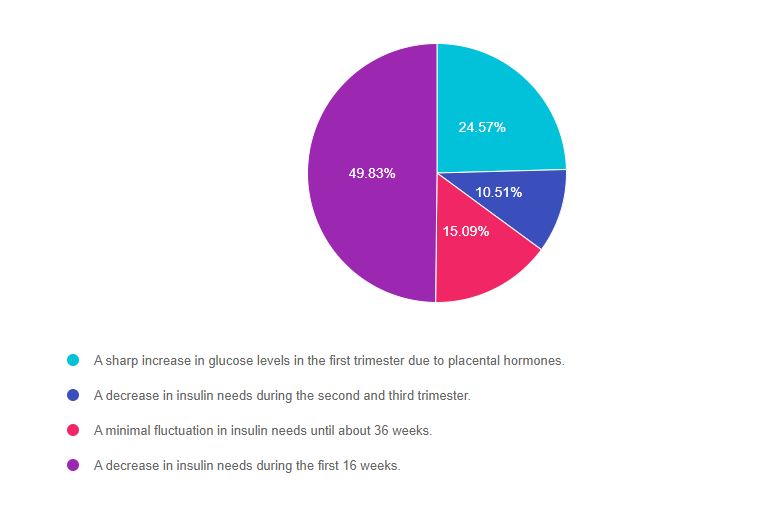
For our June 22nd Question of the Week, 64% of respondents chose the best answer. Since many diabetes specialists aren’t exposed to the care of people with diabetes during pregnancy, we want to “take a closer look” at this question and determine strategies to choose the best response so test takers can be ready for these types of questions.
Before we start though, if you don’t want any spoilers and haven’t tried the question yet, you can answer below: Answer Question
Question: ML has type 1 diabetes, her A1c is on target and she and is hoping to get pregnant in the upcoming year.
Which of the following statement best reflects the physiologic changes associated with pregnancy?
Answer Choices:
- A sharp increase in glucose levels in the first trimester due to placental hormones.
- A decrease in insulin needs during the second and third trimester.
- A minimal fluctuation in insulin needs until about 36 weeks.
- A decrease in insulin needs during the first 16 weeks.

As shown above, the most common choice was option 4, the second most common answer was option 1, then option 3, and finally option 2.
Getting to the Best Answer
If you are thinking about taking the certification exam, the content of this practice test question will set you up for success. The exam will present questions that require test takers to be familiar with knowledge of diabetes during pregnancy,
Answers & Rationale
Answer 1 is incorrect, 24.57% chose this answer, “A sharp increase in glucose levels in the first trimester due to placental hormones.” This is not the best answer based on the pathophysiology of early pregnancy. According to ADA Standards of Care 14, “early pregnancy is a time of enhanced insulin sensitivity and lower glucose levels, many women with type 1 diabetes will have lower insulin requirements and increased risk for hypoglycemia.” Often, during the first trimester, insulin doses may need to be decreased to prevent hypoglycemia.
Answer 2 is incorrect, 10.51% of you chose this answer, “A decrease in insulin needs during the second and third trimester.” This is not the best answer based on the pathophysiology of mid and later pregnancy. According to ADA Standards of Care 14, “Around 16 weeks, insulin resistance begins to increase, and total daily insulin doses increase linearly ?5% per week through week 36. This usually results in a doubling of daily insulin dose compared with the prepregnancy requirement.”
Answer 3 is incorrect, 15.09% of you chose this answer, “A minimal fluctuation in insulin needs until about 36 weeks.” This is not the best answer based on the pathophysiology of pregnancy. Based on answers 1 and 2, blood sugars can plummet during early pregnancy and then glucose levels dramatically increase starting at 16 weeks, resulting in increasing insulin requirement of about 5% a week through week 36 of pregnancy.
Answer 4 is correct, 49.83% of you chose this answer “A decrease in insulin needs during the first 16 weeks.” GREAT JOB – Since there is increased glucose uptake by the fetus and placenta combined with enhanced insulin sensitivity in early pregnancy, blood sugars generally run lower and are associated with lower insulin requirements during the first 16 weeks.
We hope you appreciate this week’s rationale! Thank you so much for taking the time to answer our Question of the Week and participate in this fun learning activity!
Want to learn more about this topic? Enroll in our
Level 2 | Pregnancy & Diabetes Standards | 1.5 CEs

People living with diabetes who are pregnant are confronted with a variety of issues that require special attention, education, and understanding.
This course reviews those special needs while focusing on Gestational Diabetes and Pre-Existing Diabetes. Included are the most recent diagnostic criteria, management goals, and prevention of complications during pregnancy. A helpful review for the CDCES Exam and for those who want more information on people who are pregnant and live with Diabetes.
Topics include:
- Three issues that affect pregnancy with diabetes
- The unique attributes of pre-existing diabetes in pregnancy and gestational diabetes
- Diagnostic criteria and management goals for gestational diabetes
- Potential short term and long term complications of fetal exposure to hypoglycemia
- Prevention measures to keep mother and baby healthy
See Full Calendar for upcoming webinars and Virtual Courses.
Can’t make it live? All paid registrants are guaranteed access to the video presentation, handouts and podcasts.
Sign up for Diabetes Blog Bytes – we post one daily Blog Byte from Monday to Friday. And of course, Tuesday is our Question of the Week. It’s Informative and FREE! Sign up below!
[yikes-mailchimp form=”1″]Accreditation: Diabetes Education Services is an approved provider by the California Board of Registered Nursing, Provider 12640, and Commission on Dietetic Registration (CDR), Provider DI002. Since these programs are approved by the CDR it satisfies the CE requirements for the CDCES regardless of your profession.*
The use of DES products does not guarantee the successful passage of the CDCES exam. CBDCE does not endorse any preparatory or review materials for the CDCES exam, except for those published by CBDCE.









